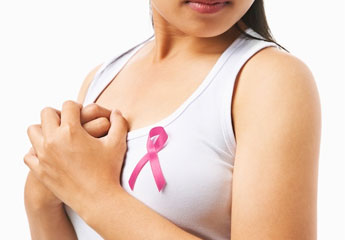
Breast cancer is one of the most common cancer’s occurring in women around the world and the most common cause of death with cancer among Hispanic women. Death toll due to cancer is quite high in most parts of world. However, death rates from breast cancer are declining in women below 50 years of age owing to increased awareness, early detection as well as improved treatment. United States itself has more than 2.8 million breast cancer survivor, this includes women who have been treated and those still undergoing treatment.
Contradictory to the belief that breast cancer occurs more commonly in individuals with family history of cancer, the statistic state that 85% of breast cancer occurs in women who have no family history while 15% of women who get breast cancer have a family member diagnosed with it. The most significant risk factors for breast cancer are gender (being woman) and age (growing older).
Early detection of breast cancer and screening can help in seeking immediate and timely medical help that prevents further complications. However early breast cancer usually does not show any specific symptoms but as the tumor grows some changes in the way breast looks and feels can be noticed and should be reported to the doctor immediately.
Typical changes include:
- A lump or thickening in or near the breast area or in the armpit.
- Nipple retraction (turning inward).
- Breast or nipple pain.
- Marked change in the size or shape of the breast.
- Puckering in the skin of the breast.
- Abnormal or watery discharge from nipples.
- Swollen or scaly or res skin on breast or areola.
Risk factors for breast cancer:
Anything which may increase the chances of breast cancer can be termed as risk factors for it. It may be either genetic or environmental or lifestyle related. Individuals with risk factors should take extra care and precautions.
Some of the risk factors are beyond our control. These are:
- Gender – Females are at higher risk of getting breast cancer compared to males.
- Aging – You are at higher risk of developing breast cancer as you get older.
- Genetic factor – 5%-10% of breast cancer are heredity.
- Mutations in genes which could be due to age or otherwise.
- Race and ethnicity – White women are more likely to develop breast cancer than African-American women, but African-American women are more likely to die due to this cancer. Asian, Hispanic and Native-American women are at a lower risk of developing or dying from breast cancer.
- Menstrual periods – Women who have more menstrual periods, owing to early menstruation and late menopause are at higher risk.
Lifestyle related risk factor:
- Women who never had children or who had their first child after 30 years are at a higher risk of developing breast cancer.
- Birth control – Women using birth control pills are at more risk of breast cancer.
- Hormone therapy after menopause can also increase risk of breast cancer.
- Breastfeeding – Some studies have suggested that breastfeeding reduces the risk of breast cancer.
- Drinking alcohol, being overnight or being obese can also increase chances of breast cancer.
Prevention of Breast Cancer:
- Control of modifiable breast cancer risk factors can lower the chances of breast cancer.
- Avoiding alcohol, being physically active, avoiding hormonal therapy if possible and eating healthy food are few things that may reduce the risk of breast cancer.
- Early detection including both Breast Self Examination and Clinical Breast Examination help in preventing advancement and spread of disease.
- Mammography screening proves beneficial for early detection.
Breast self-examination (BSE) should be done at least once a month. Let us see the 1-2-3 step of self examination:
1. In the mirror – Check changes in the normal look and feel of your breast or nipple, any changes in the size or dimpling by being in front of mirror. Inspect arms at side, arms overhead, firmly pressing hands on hips and bending forward.
2. Lying down – Lie on your back with a pillow under your right shoulder and your right hand under your head. With four fingers of your left hand make small circular motions in up and down pattern over the entire breast area, under the arms and up the shoulder bone. Repeat the same for left side using right hand.
3. While bathing – Raise your right hand and check your right breast with soapy left hand and fingers flat in similar manner as step mentioned in step 2. Repeat for other side.
If you observe any drastic change opt for a Clinical Breast Examination (CBE) which is done by a medical practitioner and covers visual and manual examination of the entire breast from collarbone to the bra line and from armpit to breastbone. Women over the age of 40 years and who have other risk factors should be referred for mammography in every 2-3 years.
Treatment:
Main treatment for breast cancer involves:
- Surgery.
- Radiotherapy.
- Chemotherapy.
- Hormone therapy.
- Biological therapy (targeted).
Either one of these treatments or a combination can be used. The choice of treatment depends on stage of cancer, age, general health, other medical issues and whether the patient has experienced menopause as well as personal preference.
